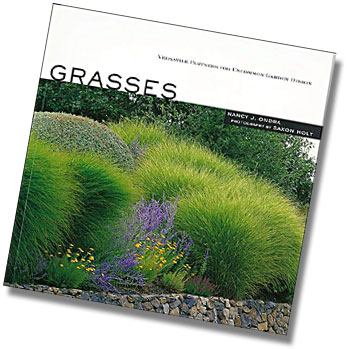|
COVER
STORY| IN THE NEWS | PUBLISHER October 13, 2005
Ornamental grassesby AMY STEWART For years, I wanted nothing
to do with ornamental grasses. I thought they were boring and
unproductive. They don't produce anything to eat and the flowers
are insignificant. They don't attract hummingbirds or butterflies.
What's the point? But over time, I've been persuaded. I realized that the ornamental grasses in my neighborhood look good year-round, and there's something to be said for that. I used to be content to fill my front yard with flowers that all burst into bloom at once in spring, but now, as we're getting ready for winter, spring is an awfully long way off. I don't know if I can stand the sight of my dormant, chopped-down-to-the-ground garden for months on end. Once I imagined the billowy silver and burgundy shapes of ornamental grasses blowing around in the wind and the rain, I was finally convinced. In the last couple of weeks, I've planted a dozen grasses in the front yard, and I've got room for more. My main source of inspiration has been a book by Nancy Ondra called Grasses: Versatile Partners for Uncommon Garden Design. Garden photographer Saxon Holt took the pictures, mostly at botanical gardens around the country, and they are breathtaking. In fact, even if you're not interested in grasses, the book would be worth getting just to study his technique. My garden photographs turn out to be a muddy mess, but his are sharp, bright and perfectly composed. And Nancy knows what she's talking about. The book is aimed at people who want to work grasses into a naturalistic perennial garden, so there are plenty of creative ideas for pairing grasses with lavender, salvia, sedum, aster and even roses and lilies. (The variegated Miscanthus grass is a cheerful and, as she says, "preppy" companion for pink roses, for example.) There are chapters on front yard gardens, shady gardens, pondside plantings and even container gardens. Not all grasses are grasses, and this book covers a number of grass-like plants as well as true grasses. Nancy offers this garden rhyme to help you tell the difference: "Sedges have edges and rushes are round; grasses are hollow and rush all around." I'll never remember that, but with her illustrations in front of me, I can tell you that in fact, sedges have stems that form long, skinny triangles, while rushes have solid cylindrical stems and true grasses have round, hollow stems. She also identifies the various flower forms most grasses offer --- spikes, racemes, panicles and awns --- and separates out the clumpers from the creepers, the mounded from the tufted, and banishes the most invasive grasses entirely. However, some grasses are invasive in one part of the country but not in another, so her list of problem grasses is limited to the very worst offenders. Do check with the nursery if you're not sure what you're buying. The North Coast Chapter of the California Native Plant Society lists a number of native grasses at its website (go to northcoastcnps.org/ls_grdn.htm), including California oatgrass, California fescue and blue bunchgrass. While some grasses are drought-tolerant, others, especially the reeds, thrive in wet, marshy areas. Be sure to choose a grass that can handle the conditions in your garden, and remember that even plants that can survive dry summers will still need supplemental water for the first year or two while they get going. After that, you can actually use water to control the growth of the grass --- if you want it to be shorter and tougher, hold back the water, but if you want something with more height and lushness, try watering more. Grasses also don't need a lot of fertilizer. In fact, too much nitrogen will actually produce more growth than is good for the plant, causing it to put out so much soft greenery that it flops over. Just work in some compost when you plant, and mulch every fall to keep it healthy. In fact, grasses will typically require less maintenance than the rest of your plants do. Some benefit from a haircut in the winter, but many only need the dead foliage raked out from time to time. Clump-forming grasses should be divided every few years to keep the oldest growth in the center from dying out, and some grasses are so vigorous that you may want to cut out sections just to keep them down to a manageable size. What I like most about the idea of working ornamental grasses into my garden is the way in which those soft, rounded shapes will support some of the other perennials that are nearing the end of their season. Yarrow flowers, for instance, turn brown this time of year but still make for an interesting shape on the end of the flower stalk. The same is true of gaura, tall purple verbena and echinacea. Why bother cutting them back when I can let the stalks and dried seed pods stay on the plants all winter? It never looked right to leave the dry, brittle bones of the garden standing through winter before, but the grasses give the garden this relaxed, natural feel that lends itself to letting everything go to seed. That's just what I intend to do. Send garden news to amystewart@northcoastjournal.com, or write in care of the Journal at 145 G St., Suite A, Arcata, 95521. COVER
STORY| IN THE NEWS | PUBLISHER Comments? Write a letter! © Copyright 2005, North Coast Journal, Inc. |


